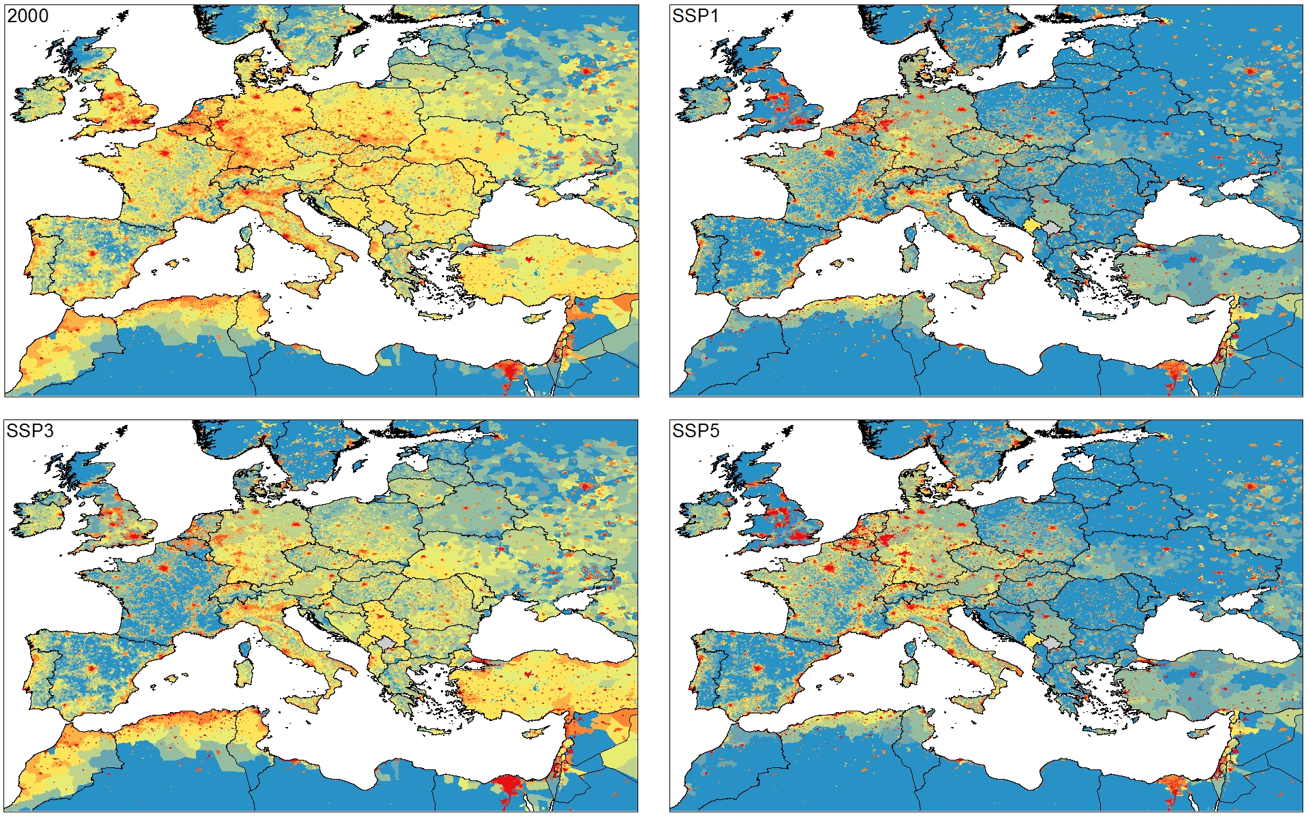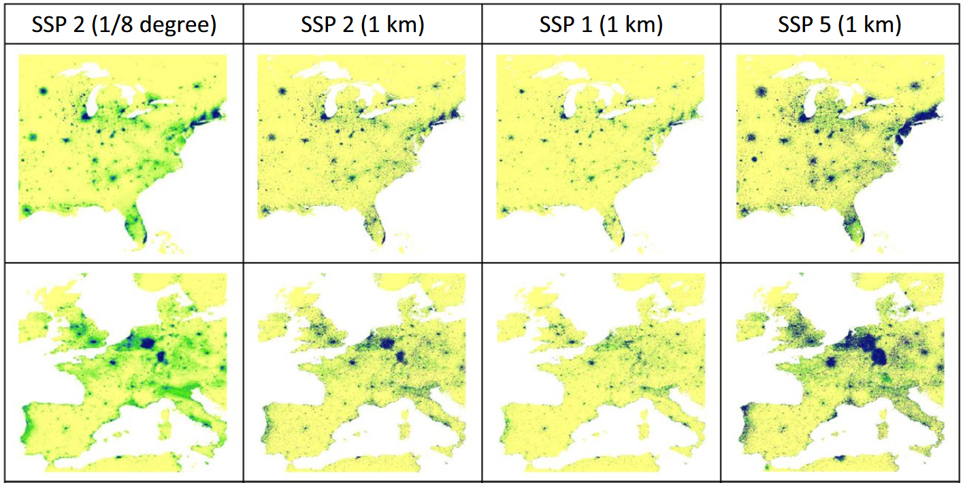Exposure datasets#
A variety of exposure datasets are available at pan-European scale that can be selected based on the data needs in terms of spatial and temporal resolution and the underlying acquisition or modeling approach. We describe a selected set of exposure datasets, including current exposure and future projections, in more detail below.
A range of population datasets are available, with different spatial and temporal resolutions, such as the satellite-based Global Human Settlement Layer (GHSL) population data GHS-POP, available at \(100 m/3 arcsec\) and \(1 km/30 arcsec\) from 1975 to 2030 in 5-year time steps. GHS-POP spatially disaggregates census unit-level population numbers with the help of built-up land derived from satellite imagery. Further, WorldPop provides population data in annual time steps for the period 2000-2020 based on a Random Forest modelling approach. GHS-POP and WorldPop are based on the Gridded Population of the World (GPW) (version 4) that have a spatial resolution of 30 arc seconds and a temporal resolution of 5-year time steps from 2000-2020, collected from the national census and population registries. Figure 1 visualizes the three global population datasets for Central Europe.
At the European scale, several population datasets are worth mentioning. The GEOSTAT population grids have a spatial resolution of 1 km and are available for the years 2006, 2011, 2018, 2021. While the years 2011 and 2021 are based on census data, the other years use land cover data and built-up land to disaggregate the population spatially. The Historical Analysis of Natural HaZards in Europe (HANZE) database v2.0 provides population raster data at 100 m spatial resolution for the years 1870-2020, derived from the GEOSTAT data of 2011. On an administrative unit level, i.e. NUTS regions, population data are available from Eurostat and the RDH. An overview of the datasets described in this section can be found in Table 1.
Dataset |
Spatial scale |
Temporal resolution |
Spatial resolution |
Analysis type |
References |
Pros |
Cons |
|---|---|---|---|---|---|---|---|
GHS-POP |
Global |
1975-2030 |
100 m, 3 arcsec; |
Spatial distribution based on built-up land |
Lightly modelled based on census data and Landsat imagery; |
Overconcentration of population where built-up land undetected (less problematic in Europe) |
|
Global |
2000-2020 |
3 arcsec, 30 arcsec |
Random Forest algorithm |
High spatial and temporal resolution |
Modelling algorithm based on several input datasets |
||
GPW v4 |
Global |
2000-2020 |
30 arcsec |
National census and population registries |
Unmodeled |
Different spatial and temporal input data |
|
GEOSTAT |
Europe |
2006, 2011, 2018, 2021 |
1 km |
Derived and modelled from census data |
Based on census data of 2011 and 2021 |
No pan-European coverage; |
|
HANZE 2.0 |
Europe |
1870-2020 |
100 m |
Modelled from GEOSTAT 2011 |
High spatial and temporal resolution |
No pan-European coverage |
|
EUROSTAT |
Europe |
1960-2023 |
NUTS regions |
National census and population registries |
Consistent across EU countries |
No pan-European coverage |

Fig. 11 Spatial population distribution in GHS-POP, WorldPop, and GPW v4#
Several datasets that represent settlements, buildings, infrastructure, and different land uses are available.
GHSL provides raster data of built-up land and volume, residential and non-residential settlement zones (Morphological Settlement Zones), settlement classes, and building height at 2 m to 1 km/ 30 arc seconds spatial resolution and a temporal resolution of five-year time steps from 1975 to 2030 for most datasets. It also provides built-up land data summarized at Local Administrative Unit Level (LAU) for 1975-2020.
Open Street Map (OSM) provides spatial data in vector format (i.e. points, lines, polygons) of e.g. building footprints and types, health and education facilities, energy and telecommunication towers, and roads and railway networks. This crowd-sourced data product is continuously updated by the OSM community.
The Critical Infrastructure Spatial Index (CISI) is based on OSM data and is available in raster format at a spatial resolution of 0.1 decimal degrees.
For assessing the exposure of different land uses, the Europe-wide CORINE land cover data are available for 44 land cover classes at 100 m spatial resolution for the years 1990, 2000, 2006, 2012, and 2018. The CORINE data provide the basis for the higher-detail LUISA land cover map, available for 2012 and 2018 at 50 m spatial resolution. Compared to CORINE, the LUISA Base Map delivers a higher overall spatial detail and finer thematic breakdown of artificial land use/cover categories (17 categories instead of 11 in CORINE). The LUISA Base Map can be used for multiple purposes, and it is more suitable than CORINE for applications requiring fine spatial and/or thematic detail of land use/land cover consistently across Europe, such as land use/cover accounting and modelling. Based on the LUISA land cover map of 2018 combined with OSM data, the European Settlement Map (ESM) was developed at 2 m spatial resolution, including residential versus non-residential buildings.
SPAM is a global crop distribution model covering 42 crops and four different technologies available for 2010 (latest) on a 5 arc-minutes crop-specific grid. The model outputs include both harvested and physical cropland. The Gridded Livestock of the World maps (GLW) show the density of eight different livestock animals in 2010 and 2015 on a 5 arc-minutes animal-specific grid and can be used to represent the exposure of animal husbandry systems. The Global Agro-Ecological Zones (GAEZ) platform provides a range of datasets for agriculture exposure and vulnerability in 2010 values. For instance, the Aggregate Crop Production Value (US$) can be the exposure term in an agricultural drought risk assessment.
Variable |
Dataset |
Spatial scale |
Temporal resolution |
Spatial resolution |
References |
Pros |
Cons |
|---|---|---|---|---|---|---|---|
Settlements |
Global |
1975-2030 |
From 10 m to 1km/30 arcsec |
European Commission, 2023 |
Global coverage; Different products (e.g. built-up land and volume, building height, residential and non-residential settlements) |
Uncommon coordinate reference system: Mollweide |
|
ESM |
Europe |
2018 |
2 m |
Very high resolution; Distinguishes residential and non-residential buildings |
Ukraine missing |
||
Buildings, Infrastructure |
Global |
Most recent |
Vector data (points, lines, polygons) |
OpenStreetMap contributors, 2023 |
High spatial detail; Good coverage in northern Europe |
Working with the data can be cumbersome (e.g. download, selection); Limited coverage in southern Europe |
|
Infrastructure |
CISI |
Global |
2021 |
0.1 degree |
Input data and final index in raster format; Easy to use (compared to OSM) |
Low resolution |
|
Land cover |
CORINE |
Europe |
1990, 2000, 2006, 2012, 2018 |
100 m |
Relatively long time series |
Fewer land cover categories or less spatial detail than LUISA |
|
Europe |
2012, 2018 |
50 m |
17 land cover categories |
Ukraine missing; Mixed land use in a cell |
|||
Global |
2010 |
5 arc minutes |
42 crops available |
Low resolution |
|||
Global |
2020 |
5 arc minutes |
46 crops available |
Low resolution |
|||
Livestock density |
Global |
2010, 2015 |
5 arc minutes |
8 different animals |
Low resolution |
||
Competition on water |
Global |
1979-2019 |
Hydrological sub-catchment scale |
Global coverage |
Scaled for hydrological sub-catchments |
||
Aggregate Crop Production Value |
Global |
2010 |
5 arc minutes |
Global coverage |
Low resolution |
||
Global |
2020 |
5 arc minutes |
Global coverage |
Low resolution |

Fig. 12 The CISI for Western Europe (figure adjusted from Nirandjan et al. 2022)#
Table 3 provides an overview of future projections datasets currently available. Future projections of the population until 2100 are available under a range of socioeconomic scenarios, the Shared Socioeconomic Pathways (SSPs) (O’Neill et al., 2017). Publicly available datasets include those of Merkens et al. (2016) and Wang et al. (2022), which are available at a spatial resolution of 30 arc seconds. However, they are based on different modelling approaches and underlying population data used as model input. For instance, the population projections of Merkens et al. 2016 were specifically developed to account for coastal migration processes. Further population projections are available from GHSL at 1 km spatial resolution (Directorate General for Regional and Urban Policy (DG REGIO) of the European Commission, 2020), or from IIASA Global Community Water Model (5 arc minutes) upon request. Projections of future urban land are available for the SSPs until 2100, such as the data of Gao and O’Neill (2020) at 1/8-degree spatial resolution, also downscaled to 1 km, and Chen et al. (2020), available at 30 arc seconds. Additionally, projections of different land uses are available at 30 arc seconds resolution until 2100 (Chen et al., 2022; Zhang et al., 2023), and GHSL provides projections per settlement class (GHS-SMOD) at 1 km resolution until 2070 (Kemper et al., 2022).
Variable |
Scenario |
Temporal resolution |
Spatial resolution |
Acquisition/modelling approach |
References |
Pros |
Cons |
|---|---|---|---|---|---|---|---|
Population |
SSPs 1-5 |
2010-2100 |
30 arcsec |
Population growth in coastal, inland, urban, and rural locations |
Global coverage |
Developed with coastal applications in mind |
|
SSPs 1-5 |
2020-2100 |
30 arcsec |
Random Forest algorithm |
Global coverage |
Modelling algorithm based on several input datasets |
||
SSP-RCP combinations |
2015-2100 |
5 arcmin |
Global CWatM |
Global coverage |
Dataset not public, but available upon request |
||
Urban land |
SSPs 1-5 |
2015-2100 |
1 km |
Artificial Neural Network algorithm |
Global coverage |
Modelling algorithm based on several input datasets |
|
SSPs 1-5 |
2000-2100 |
1/8 decimal degree, 1 km |
Monte Carlo simulations |
Global coverage |
Produced at 1/8 decimal degrees and downscaled to 1 km |
||
Land cover |
SSP-RCP combinations |
2015-2100 |
30 arcsec |
Cellular automata |
Based on CMIP6; global coverage |
Modelling algorithm based on several input datasets |
|
Competition on water |
SSP-RCP combinations |
2030-2080 |
Hydrological sub-catchment scale |
Modelled (Aqueduct v4) |
Global coverage |
Scaled for hydrological sub-catchments |

Fig. 13 Population projections by Merkens et al. 2016: Base year (2000) and SSP1, 3, 5 (2100)#

Fig. 14 Urban land projections for North America and Europe in 2100 under SSP2, SSP1 and SSP5. Comparison of 1/8 degree spatial resolution (panel 1) to 1 km (panels 2-4) (adjusted from Gao & Pesaresi 2021)#
